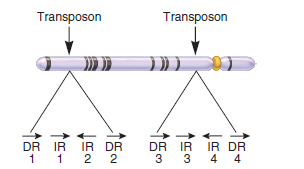
Genetics: Analysis and Principles 5th Edition by Robert Brooker
Edition 5ISBN: 978-0073525341
Genetics: Analysis and Principles 5th Edition by Robert Brooker
Edition 5ISBN: 978-0073525341 Exercise 29
Solved problem S2 illustrates the consequences of crossing over between the direct and inverted repeats within a single TE. The drawing here shows the locations of two copies of the same TE within a single chromosome. The chromosome is depicted according to its G banding pattern. (Note: G bands are illustrated in Figure 8.1.) The direct and inverted repeats are labeled 1, 2, 3, and 4, from left to right. 
a.
Draw the end result of recombination between the following sequences. Your drawing should include the banding pattern of the resulting chromosome
a. DR-1 and DR-4
B. IR-1 and IR-4
FIGURE 8.1 Features of normal chromosomes. (a) Micrographs of chromosomes from a human, a fruit fly, and corn. (b) A comparison of centromeric locations. Centromeres can be metacentric, submetacentric, acrocentric (near one end), or telocentric (at the end). (c) Human chromosomes that have been stained with Giemsa. This micrograph has been colorized to more easily discern the banding patterns. (d) The conventional numbering of bands in Giemsa-stained human chromosomes. The numbering is divided into broad regions, which then are subdivided into smaller regions. The numbers increase as the region gets farther away from the centromere. For example, if you take a look at the left chromatid of chromosome 1, the uppermost dark band is at a location designated p35. The banding patterns of chromatids change as the chromatids condense. The left chromatid of each pair of sister chromatids shows the banding pattern of a chromatid in metaphase, and the right side shows the banding pattern as it would appear in prometaphase. Note: In prometaphase, the chromatids are less compacted than in metaphase.
a.
Problem S2
Recombination involves the pairing of identical or similar sequences, followed by crossing over and the resolution of the intertwined helices. On rare occasions, the direct repeats or the inverted repeats within a single TE can align and undergo homologous recombination. What are the consequences when the direct repeats recombine What are the consequences when the inverted repeats recombine

a.
Draw the end result of recombination between the following sequences. Your drawing should include the banding pattern of the resulting chromosome
a. DR-1 and DR-4
B. IR-1 and IR-4
FIGURE 8.1 Features of normal chromosomes. (a) Micrographs of chromosomes from a human, a fruit fly, and corn. (b) A comparison of centromeric locations. Centromeres can be metacentric, submetacentric, acrocentric (near one end), or telocentric (at the end). (c) Human chromosomes that have been stained with Giemsa. This micrograph has been colorized to more easily discern the banding patterns. (d) The conventional numbering of bands in Giemsa-stained human chromosomes. The numbering is divided into broad regions, which then are subdivided into smaller regions. The numbers increase as the region gets farther away from the centromere. For example, if you take a look at the left chromatid of chromosome 1, the uppermost dark band is at a location designated p35. The banding patterns of chromatids change as the chromatids condense. The left chromatid of each pair of sister chromatids shows the banding pattern of a chromatid in metaphase, and the right side shows the banding pattern as it would appear in prometaphase. Note: In prometaphase, the chromatids are less compacted than in metaphase.

a.
Problem S2
Recombination involves the pairing of identical or similar sequences, followed by crossing over and the resolution of the intertwined helices. On rare occasions, the direct repeats or the inverted repeats within a single TE can align and undergo homologous recombination. What are the consequences when the direct repeats recombine What are the consequences when the inverted repeats recombine
Explanation
A.When the recombination occurs between ...
Genetics: Analysis and Principles 5th Edition by Robert Brooker
Why don’t you like this exercise?
Other Minimum 8 character and maximum 255 character
Character 255



